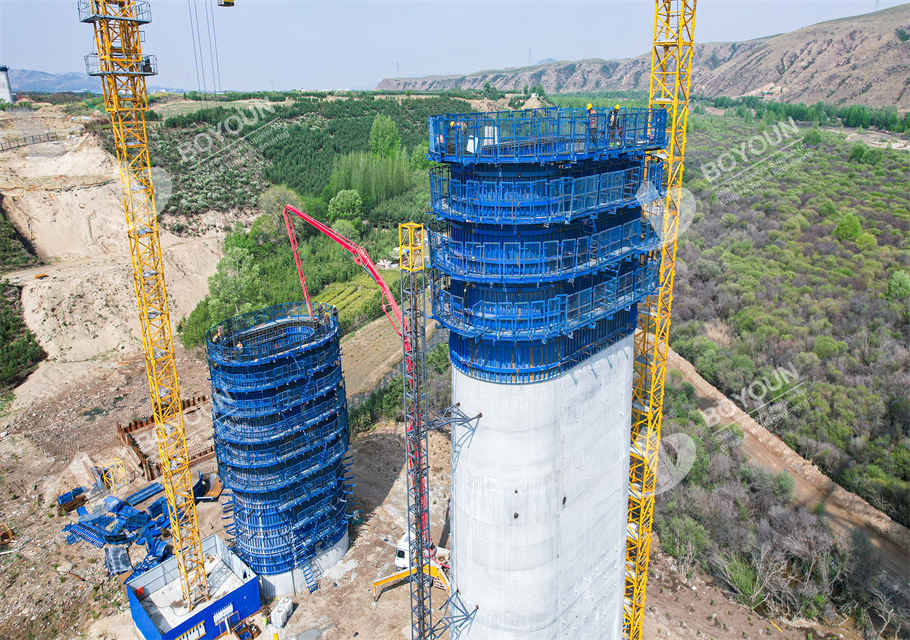Cylindrical steel formworks are suitable for many construction scenarios, most of which are in bridge engineering. Furthermore, some special buildings also require the use of cylindrical formworks. Additionally, using cylindrical formworks is better than ordinary square formworks as it can save some construction time. The relevant construction process can be divided into the following parts.

Many people tend to overlook this point. They often start preparing during the installation process, which results in a low fault tolerance rate and is highly likely to cause installation quality problems. Before installation, the flatness of the inner and outer formwork of the cylindrical formwork should be thoroughly inspected, and the quantity of matching steel belts and screw rods should be checked to ensure they are complete.
The overall installation plan should be determined based on the cylinder's height. For instance, for a height of 5 meters, the 3-2 or 2-2-1 staggered installation methods can be selected. For the semi-circular joints in the up-down direction, they can be tightened with steel belts to prevent slurry leakage.
When installing the cylindrical formwork, attention should be paid to the inspection of the installation platform. Many construction units also overlook this point and often start laying the foundation during the installation process, which is an incorrect method. A flat installation platform should be at the bottom, especially for columns with a height exceeding 3 meters. After placing two semi-circular formworks on the installation platform for preliminary fastening, the bottom of the formwork should be filled with concrete. The benefits of filling seams with concrete include preventing slurry leakage during pouring and making it easier to remove formwork
The fastening of steel belts begins from the bottom up. Everyone should pay attention to this and avoid disrupting the order. Generally, cylindrical formwork has concave-convex groove designs, which can be used for the preliminary fastening of the cylindrical formwork, and then steel belt operation. Also, this work is typically completed by several people or a group working together. The steel belts should be parallel with an average spacing of 30 cm.
After the cylindrical formwork is installed successfully, attention should be paid to the slurry leakage problem in the concave-convex grooves to prevent honeycomb spots on the columnar building. The concave-convex grooves can be taped in advance. After taping the concave-convex grooves, installation can be carried out. After concrete is poured, if the concrete is attached to the concave-convex grooves, the tape can be removed. This step can be repeated during the next formwork erection.
The maximum height of custom cylindrical formworks is 3 meters. When the cylinder exceeds 3 meters, staggered lap installation is necessary.
The matching steel belts play a crucial role in the entire reinforcing system. The average spacing between the steel belts is generally around 30 cm. It's crucial to keep the steel belts horizontal during installation.
The concave-convex groove design plays a crucial role in fastening two pieces of cylindrical formwork. However, mortar can easily enter the grooves. Before fastening, transparent tape can be pasted inside the concave and convex grooves, and then they will be fastened. After the concrete is poured and the formwork is removed, the tape can be removed.
1. Personnel entering the construction site should wear safety helmets and those working at heights should firmly fasten their safety belts.
2. When removing the formwork, cooperation and coordination are necessary. Tools should not be thrown when being passed.
3. When setting up the formwork, the site should be cleaned up after the work is completed and the necessary materials should be placed neatly.
4. When hoisting and transferring the formwork, there should be a dedicated person for directing, and no illegal operations are allowed.
5. Before entering the site, employees should undergo environmental protection education to increase their environmental protection awareness.
6. Strengthen mechanical management to reduce noise during construction.
Cylindrical steel formworks are widely used in construction, particularly in bridge engineering. They can save construction time compared to square formworks. The construction process includes: preparation before installation, checking the flatness of the formwork and accessories; determining the plan based on the height of the cylinder, for example, using specific staggered installation methods for a 5-meter high cylinder to prevent slurry leakage; attaching great importance to the installation platform, especially ensuring its flatness and filling the seams for high columns; correctly fastening the steel belts; preventing slurry leakage and mortar from entering the concave - convex grooves; using the staggered lap method for cylinders over 3 meters; horizontally installing the matching steel belts. During construction, attention should be paid to safety, environmental protection, and proper operation. Let's strictly follow the process to guarantee construction quality and safety!

International Department: Room 2507-2508, Tower C of Wanda Plaza, Tongzhou District, Beijing 101118, China.
+86-13021287080
info@boyoun.cn